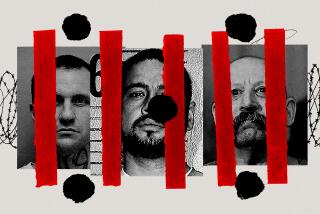John Doe 142: Dead, Unknown in the Street
He was just a kid, out way too late on a Saturday night, riding his bike to nowhere.
On Sunday morning, they found his body, and his bike, on the sidewalk in front of the parish school of Ascension Catholic Church in South-Central Los Angeles; when the police came knocking, a nun in the nearby church residence told them that yes, she had heard some gunshots a little after 3 a.m., but around there, the sisters heard them all the time.
This time, the shots--a fusillade of shots from a handgun--had found their mark.
At first glance, he was a black youth, as young as 14 or as old as 18, a bit in need of a haircut, wearing stylish black parachute pants, a brown plaid shirt under a gray jacket, and worn white basketball shoes--ordinary clothes, like “what you’d buy a 14-to-16 year-old at Sears,” said Los Angeles Police Officer Roger Magnuson.
More than three weeks later, that is still all that police know about their murder victim, John Doe 142. No anxious relative has come looking for him, no conscientious neighbor has called police.
“This case is a rarity--some mother somewhere hasn’t missed him,” said Magnuson, who, with his partner, has spent the last fortnight hunting for two names--one for the boy, and one for the person who killed him.
In these weeks since the June 15 killing, the obvious avenues of inquiry have petered out, and Magnuson and partner Ray Terrones are down to the twisting alleys of investigation. But “it’s been a dead-end every time.”
For starters, they knocked on hundreds of doors along 111th Place, showing the youth’s picture to neighbors, who shook their heads.
Then they traced the anonymous phone call that came in about 20 minutes after the shooting, telling police that there was a body on 111th Place near Figueroa Street. It was made at a public phone booth two blocks away.
And then Magnuson and Terrones, both with the South Bureau’s CRASH anti-gang force, pulled in the gang leaders operating in that quadrant of the urban battlefield. Who was this fellow?
The gang leaders shook their heads. They had not seen him before. He ought to know, one of them told police: “My life depends on me knowing all the kids in my area.”
John Doe 142 wasn’t wearing gang “colors,” police had noted. If he had been a “Blood,” his shoes might have been threaded with red laces, or blue ones if he were a “Crip.” He might have inked his gang nickname on the instep of his shoes. But John Doe 142 wore old, white high-top sneakers with white laces, and there was no writing on them.
Man, one of the gang leaders remarked to the cops, he kinda dressed like a nerd.
Magnuson believed them. If it had been a gang member killed, then someone else would have died by now, in retaliation. And all the checks on all the state’s crime computers, adult and juvenile, came up with zero. “Basically, the kid had no record,” Magnuson said.
Perhaps it was a drug-related hit--but this is not a big drug area, Magnuson said, and the closest rock joints are a good 10 blocks away.
Maybe he was robbed--his pockets held nothing, not even lint. With 20 minutes elapsing between the gunshots and the phone call, “it’s possible he was robbed,” Magnuson said. But the bike, a small Redliner with big tires and chromed wheels and hand brakes--one yellow and one blue--still lay a few feet from the body when police got there.
Even a federal list of 15 runaways from Fresno to San Diego, all approximately matching the boy’s description, has washed out so far. None of them had John Doe 142’s eight-inch scar on the right leg, nor the small scar on the upper left lip.
“We know there are probably some other witnesses out there,” Magnuson sighed. “It’s frustrating.”
More to Read
Sign up for Essential California
The most important California stories and recommendations in your inbox every morning.
You may occasionally receive promotional content from the Los Angeles Times.











